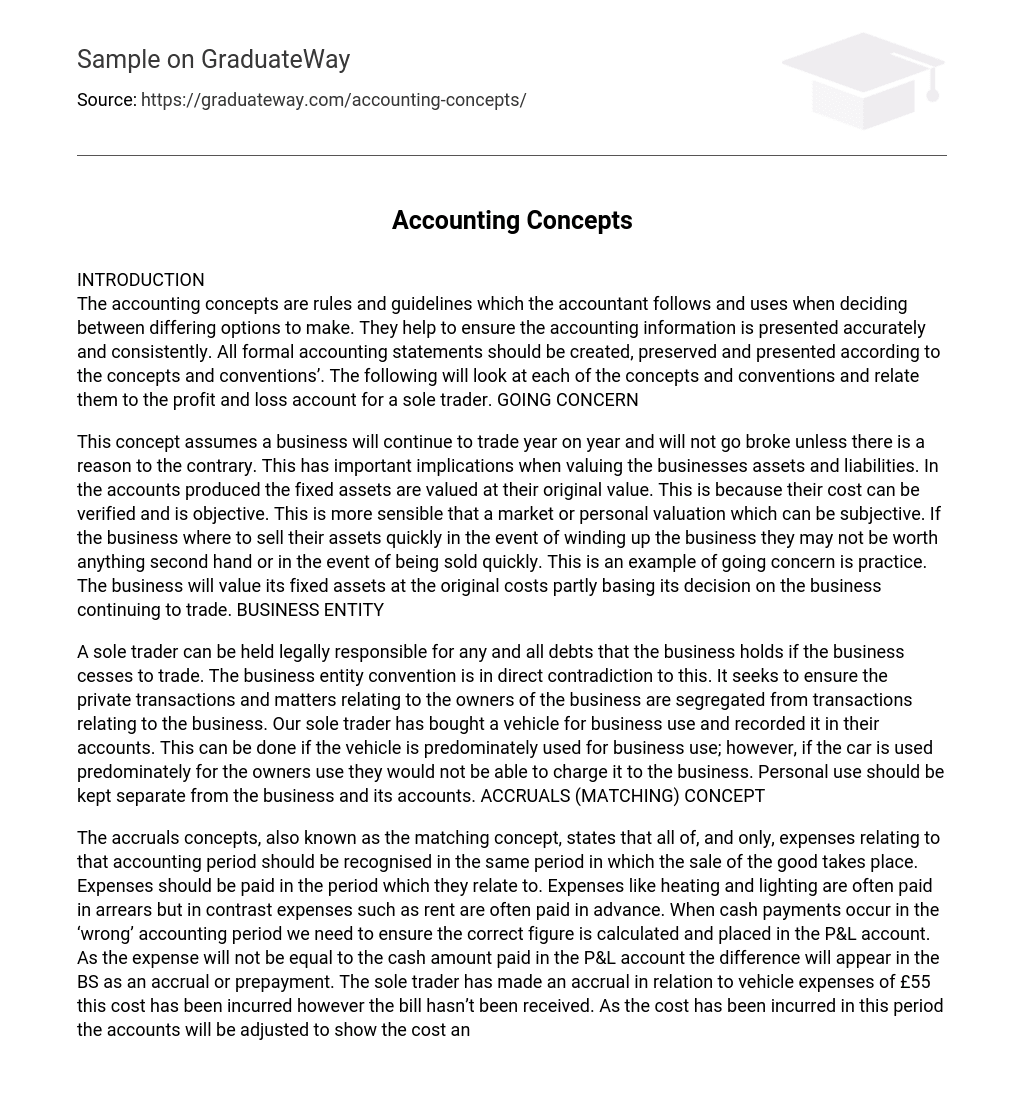INTRODUCTION
The accounting concepts are rules and guidelines used by accountants to make decisions. These concepts ensure the accuracy and consistency of accounting information. All formal accounting statements should be created, preserved, and presented based on these concepts and conventions. The following will examine each concept and convention and how they relate to the profit and loss account for a sole trader. GOING CONCERN
The concept of going concern assumes that a business will continue to operate and not go bankrupt, unless there is evidence to the contrary. This has important implications when determining the value of the business’s assets and liabilities. In the financial statements, the fixed assets are valued at their original cost. This approach is preferred because the cost of these assets can be verified objectively, unlike a subjective market or personal valuation. If the business were to quickly sell its assets in the event of liquidation, they may not fetch any value in the second-hand market or when sold hastily. This example demonstrates the practice of going concern, as the business values its fixed assets based on the assumption that it will continue to operate. BUSINESS ENTITY
A sole trader may be legally responsible for all debts incurred by the business if it ceases operations. However, the concept of a business entity aims to separate personal matters from those related to the business. In this case, the sole trader has bought a vehicle for business purposes and recorded the transaction in their accounts. This is allowed if the vehicle is mainly used for business activities. If it’s primarily used for personal reasons, it cannot be charged to the business. It’s crucial to differentiate between personal use and business-related activities in financial records and expenses. This principle is called the accruals (matching) concept.
The accruals concept, also referred to as the matching concept, states that only expenses related to a specific accounting period should be recognized in that same period when the sale of the goods occurs.
Expenses should be paid in the period they are related to. Expenses like heating and lighting are typically paid in arrears, while expenses such as rent are often paid in advance. When cash payments occur in a different accounting period, it is necessary to calculate and record the correct figure in the P&L account. Since the expense will not match the cash amount paid in the P&L account, any difference will appear in the balance sheet as an accrual or prepayment. For example, the sole trader has accrued £55 for vehicle expenses which have been incurred, but the bill has not been received yet. As this cost has been incurred during this period, the accounts will be adjusted to reflect the cost, and the accrued figure will be included in the balance sheet. This is done to ensure materiality in financial reporting.
The preparation of accounts requires a considerable amount of judgement in determining whether to classify something as an asset or an expense. For example, a sole trader may purchase both a vehicle and some light bulbs for their business. However, only the vehicle will be recorded as an asset, as it is deemed significant enough to the operation of the business. The light bulbs may be categorized as general expenses, given their lesser significance. This categorization is subjective and what may be considered material for one business may be immaterial for another. This practice reflects prudence.
The term “prudence” is synonymous with conservatism. It can be best described by the well-known phrase “anticipate no profit and provide for all possible losses.” Prudence entails taking a cautious approach by considering all potential issues or costs to the business and making provisions for them in the accounts as soon as they are likely to be incurred. Profits are not recognized until the completion of a sale. An illustration of prudence in accounting includes making provisions for bad debts and depreciation. These provisions account for any potential issues as soon as they are anticipated. Depreciation acknowledges the decrease in value, wear and tear, and eventual replacement of a business’s fixed assets. All of these examples demonstrate the application of prudence. Additionally, objectivity is important in accounting.
Accounts should be prepared in a fair and factual manner, adhering to objectivity. A valid illustration of this principle is the treatment of fixed assets. The original cost is preferred as it can be verified and is more unbiased compared to personal or market valuations. Nonetheless, there is scope for some subjectivity in certain areas of accounting, such as depreciation provision. Determining the depreciation period and selecting the appropriate method involve judgments that may not be entirely objective. In our financial statements, the sole trader has opted for the original cost of their fixed assets as the basis for valuation, displaying consistency in their approach.
Consistency is essential for making meaningful comparisons of financial performance. This entails treating transactions and valuation methods consistently from year to year. For instance, our sole trader has consistently used the straight line depreciation method, even if it may not be the optimal choice for the business. By maintaining this consistency, users of accounts can accurately compare financial performance over time. Making frequent changes would only serve to mislead and confuse the user.
CONCLUSION
Accountants depend on these principles and norms as the foundation for their work, despite potential conflicts. However, the main goal is for the company to present precise and impartial financial statements to all users.
References:
The following sources provide information on accounting concepts and conventions:
– Geoff, J. (2001). Accounting Concepts and Conventions. Retrieved April 30th, 2010, from Tutor2u
– Ireland, J. (2005). Principles of Accounting. Retrieved April 30th, 2010, from Principles of Accounting
– Williamson, D. (2001, September 3rd). Accounting Concepts and Conventions. Retrieved April 30th, 2010, from Duncan Williamson





